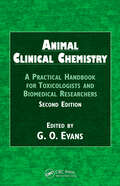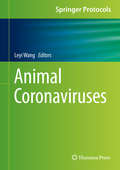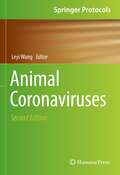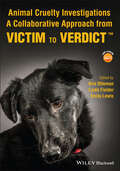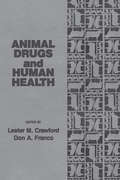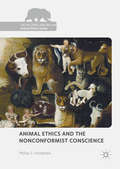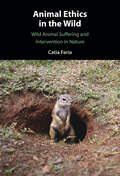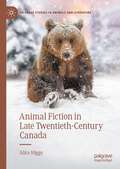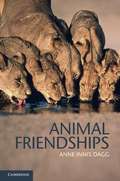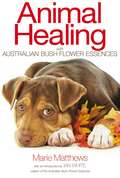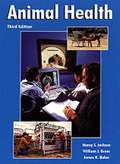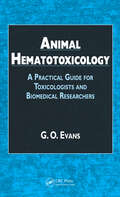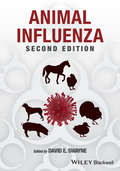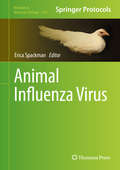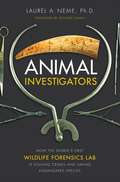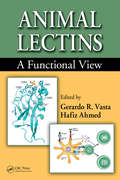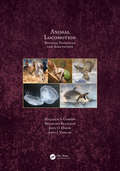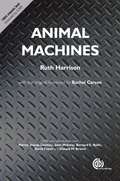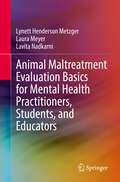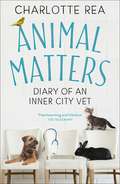- Table View
- List View
Animal Clinical Chemistry: A Practical Handbook for Toxicologists and Biomedical Researchers, Second Edition
by G. O. Evans10+ Years of Updates Since First EditionNewcomers to the animal clinical chemistry and toxicology fields quickly find that the same rules of human medicine do not always apply. Following in the footsteps of its standard-setting first edition, Animal Clinical Chemistry: A Practical Handbook for Toxicologists and Biomedical Researchers, Second Editio
Animal Coronaviruses (Springer Protocols Handbooks)
by Leyi WangThis detailed volume provides diagnosticians and researchers with practical methodologies and approaches to tackle animal coronaviruses. It explores conventional immunohistochemistry, virus neutralization, enzyme-linked immunosorbent assays, expression and purification of recombinant viral proteins, and various molecular assays, including conventional and real-time reverse transcription-PCR, reverse genetics methodology, and next generation sequencing and sequence analyses. As part of the Springer Protocols Handbooks series, chapters contain readily reproducible laboratory protocols as well as expert tips on troubleshooting and avoiding known pitfalls. Practical and authoritative, Animal Coronaviruses serves as an ideal reference for researchers examining a wide variety of coronavirus species in the Coronaviridae.
Animal Coronaviruses (Springer Protocols Handbooks)
by Leyi WangThis detailed new edition compiles fully updated practical methodologies and approaches for diagnosticians and researchers working toward a better understanding of animal coronaviruses. The book explores vital techniques in virus isolation, diagnostic approaches via the detection of viral nucleic acids or proteins, serology, disease-targeted animal species models, and next-generation sequencing and bioinformatics. Written for the invaluable Springer Protocols Handbooks series, chapters contain readily reproducible laboratory protocols as well as expert tips on troubleshooting and avoiding known pitfalls. Thorough and hands-on, Animal Coronaviruses, Second Edition will help readers design and carry out their increasingly important projects in clinical research, diagnostics, disease surveillance, and epidemiological study involving this family of viruses.
Animal Cruelty Investigations: A Collaborative Approach from Victim to Verdict
by Linda Fielder Emily Lewis Kris OttemanAnimal Cruelty Investigations: A Collaborative Approach from Victim to Verdict provides a framework for the experts who respond to animal cruelty cases: veterinarians, law enforcement agencies, animal care and control organizations, and prosecutors. This book is a practical guide which provides insight and direction for every phase of an animal cruelty investigation. The step-by-step guidance on responding to particular issues and challenges related to animal cruelty cases is bolstered by the extensive library of checklists, form templates, specific case protocols, and lists of available resources. This book is designed to empower readers to respond to animal cruelty cases confidently and effectively by: Introducing veterinarians to their critical role in animal cruelty investigations including forensic examination and necropsy, crime scene response, report writing, and testimony. Included are detailed Specific Case Protocols for common animal cruelty scenarios. Helping animal shelters navigate the challenges of holding animals in protective custody, housing unusual species, and placing evidence animals in foster care. Offering law enforcement agencies useful methods for investigating animal cruelty such as search and seizure protocols, witness interview techniques, and valuable forms and templates necessary to strengthen and ensure proper search warrant execution, evidence collection and handling, and chain of custody; all with a focus on animals as both victims and evidence. Guiding prosecutors through the steps necessary to utilize the veterinarian’s findings during trial and providing insight into issues to be considered when reviewing search warrants, filing charges, proposing plea agreements, or filing pre-conviction forfeiture motions. This book is a must-have reference and guide for veterinarians, technicians, law enforcement officers, prosecutors, and all those involved in the protection of animals’ health and wellbeing. The successful investigation of animal crimes relies on each of these disciplines, not only carrying out their professional duties, but having a collective understanding of what each other needs in order to meet that expectation.
Animal Drugs and Human Health
by Lester M. Crawford Don A. FrancoThe presence of drug and chemical residues in food products from animal sources is both a public health problem and a consumer concern. This is the first book to examine and analyze this problem in a scientific, non-partisan way. The twelve contributing authors are all recognized authorities on this topics. An important resource for food scientists and analysts working with meat food products.
Animal Ethics and the Nonconformist Conscience (The Palgrave Macmillan Animal Ethics Series)
by Philip J. SampsonThis book explores the religious language of Nonconformity used in ethical debates about animals. It uncovers a rich stream of innovative discourse from the Puritans of the seventeenth century, through the Clapham Sect and Evangelical Revival, to the nineteenth century debates about vivisection. This discourse contributed to law reform and the foundation of the RSPCA, and continues to flavour the way we talk about animal welfare and animal rights today. Shaped by the "nonconformist conscience", it has been largely overlooked. The more common perception is that Christian “dominion” authorises the human exploitation of animals, while Enlightenment humanism and Darwinian thought are seen as drawing humans and animals together in one "family". This book challenges that perception, and proposes an alternative perspective. Through exploring the shaping of animal advocacy discourses by Biblical themes of creation, fall and restoration, this book reveals the continuing importance of the nonconformist conscience as a source to enrich animal ethics today. It will appeal to the animal studies community, theologians and early modern historians.
Animal Ethics in the Wild: Wild Animal Suffering and Intervention in Nature
by Catia FariaAnimals, like humans, suffer and die from natural causes. This is particularly true of animals living in the wild, given their high exposure to, and low capacity to cope with, harmful natural processes. Most wild animals likely have short lives, full of suffering, usually ending in terrible deaths. This book argues that on the assumption that we have reasons to assist others in need, we should intervene in nature to prevent or reduce the harms wild animals suffer, provided that it is feasible and that the expected result is positive overall. It is of the utmost importance that academics from different disciplines as well as animal advocates begin to confront this issue. The more people are concerned with wild animal suffering, the more probable it is that safe and effective solutions to the plight of wild animals will be implemented in the future.
Animal Fiction in Late Twentieth-Century Canada (Palgrave Studies in Animals and Literature)
by Alice HiggsAnimal Fiction in Late Twentieth-Century Canada fulfils a vital contribution to the conversation surrounding animal representation as a point of continuity in national narratives and supports the idea that focusing on narratives of responsibility and care influences better relations with both non-human animals and across settler-Indigenous boundaries. Alice Higgs engages with on-going debates regarding reconciliation by demonstrating that it is imperative to critique settler colonial environmental frameworks and place autonomy back into Indigenous communities by bringing Indigenous practices of custodianship and relationality to bear more generally. This book also develops a number of conversations in animal studies in relation to the politics of representation. Higgs studies a range of canonical Canadian authors, demonstrating a progress across the period in which it is possible to identify the emergence of a literary pro-animal turn.
Animal Friendships
by Anne Innis DaggResearch into social behaviour in animals has often focused on aggression, yet members of social species are far more likely to interact with each other in a positive way. Animal Friendships explores non-sexual bonding behaviours in a range of mammalian and avian species. Through analysis of factors which trigger and deepen friendships, Dagg uncovers a world of intricate and complex social interactions. These factors include sources of food, formation of coalitions, playdates for infants, mutual grooming and the apparent pleasure of simple companionship. Chapters cover different types of friendship: from those between two individuals, such as male-female or parent-offspring friendships, to those within family groups and even inter-species friendships. Not only does the book explore how and why friendships form, it also showcases the ingenious field techniques used by researchers enabling the reader to understand the scientific methodology. An invaluable read for both researchers and students studying animal social bonding.
Animal Handling and Physical Restraint
by C. ChastainKey features: Stresses safety in handling, restraint, and containment of animals Covers handling and restraint of all domestic and common tamed animals and provides information on normal animal behavior and welfare Discusses how to recognize signs in animals of poor handling and containment Reviews zoonotic disease risks to animal handlers, particularly from normal-appearing animals, and how to avoid transmission of disease Features over 200 informative line drawings for clarity and simplicity of illustration Explains how to tie useful knots and hitches and when to use them for restraint Includes basic ethical considerations and legal liabilities of animal handling and containment Presents steps to prevent animal escapes, barn fires, and problems with transport Authored by an experienced veterinary educator in clinical medicine for veterinarians, veterinary students, pre-veterinary students, veterinary technicians and technologists, animal scientists, and animal owners Proper handling and restraint are essential to the welfare of captive animals, allowing them to be examined, groomed and treated in ways that contribute to their optimum quantity and quality of life. The aim of the book is to prepare future or current veterinarians and veterinary technologists, technicians/nurses, and assistants to be able to handle animals more safely and gain the confidence of animals and their owners. In turn, they will be able to instruct owners in proper animal handling methods, reducing the risk of physical injury or mutual infectious diseases. Throughout the book, the author emphasises that each animal is an individual and each handling environment provides its own advantages and disadvantages: handling an animal safely, humanely and efficiently requires practical knowledge of the species’ normal behaviour. This is explored in detail in each of the species-based chapters, which cover proper handling of domestic household and laboratory animals, as well as farm and ranch animals where safe handling aids the producer in both humane practice and greater profitability. After reading this book, the practitioner or student will be versed in the most basic part of the art of veterinary medicine: the safe handling of animals.
Animal Healing with Australian Bush Flower Essences
by Marie MatthewsCarefully researched and comprehensive, this reference gives extraordinary insights into the emotional world of animals and explores the healing powers of Australian Bush Flower Essences. Providing practical hints for keeping creatures fit and happy as well as dealing with health and behavior problems, this helpful guide offers naturopathic remedies that are both safe and time saving. Exploring a variety of case studies, particular Australian Bush Flower Essences are recommended to support sound management, balanced diet, and exercise by stabilizing the energy that is essential for the well-being of animals. While this handbook focuses primarily on dogs, cats, horses, and birds, more exotic creatures are covered in the Repertory of Symptoms section offered at the close.
Animal Health (Third Edition)
by Nancy S. Jackson William J. Greer James K. BakerAnimal Health provides basic information on animal health and disease prevention. The responsibility for animal health rests first and foremost in the hands of the owner.
Animal Hematotoxicology: A Practical Guide for Toxicologists and Biomedical Researchers
by G.O. EvansHematology data from in vivo toxicology studies remains one of the most predictive measures for human risk, as the same measurements made in pre-clinical toxicology studies can be made in early clinical trials.Covering the three main blood cell types - erythrocytes, leukocytes and thrombocytes, this work is designed to clarify topics fo
Animal Influenza
by David E. SwayneAnimal Influenza, Second Edition is a comprehensive text on animal influenza. Organized by species, coverage includes avian, swine, equine and mammals, with each section including data on influenza viruses, the infection and disease they cause, and strategies used in control. Covers the full range of topics within avian, swine, equine and mammalian influenzas in one comprehensive and authoritative text Provides a summarization of peer-reviewed and empirical data on influenza viruses, the infection, and diseases they cause Discusses strategies used in control of the disease Leading experts are drawn together to provide an international and multi-disciplinary perspective Fuses latest developments in basic scientific research with practical guidance on management of the disease
Animal Influenza Virus (Methods in Molecular Biology #1161)
by Erica SpackmanAvian Influenza Virus, Second Edition aims to provide the essential methods used in working with animal influenza viruses, and to compile more advanced information that will guide the user in designing influenza studies. Influenza A viruses are among the most important pathogens for humans, food animals and companion animals. Research and diagnostics with animal influenza viruses are critical to animal health and it should be recognized that the needs and goals of animal agriculture and veterinary medicine are not always the same as those of public health. This volume sorts out the differences in the structure of the poultry, swine and equine industries, the biological differences of influenza virus from each animal group, and provides host, strain and lineage specific guidance and procedures. Written in the successful Methods in Molecular Biology series format, chapters include introductions to their respective topics, lists of the necessary materials and reagents, step-by-step, readily reproducible protocols, and notes on troubleshooting and avoiding known pitfalls. Authoritative and accessible, Avian Influenza Virus, Second Edition seeks to serve both professionals and novices with its well-honed methodologies in an effort to further our knowledge of these important pathogens. "
Animal Influenza Virus: Methods and Protocols (Methods in Molecular Biology #2123)
by Erica SpackmanThis third edition aims to provide new and updated methods on animal influenza viruses as well as more advanced protocols that will guide the reader in designing research. Chapters detail influenza in peridomestic animals, marine mammals, savian influenza, swine influenza, equine influenza, hemagglutination, genome sequencing, and influenza in other mammals. Written in the highly successful Methods in Molecular Biology series format, chapters include introductions to their respective topics, lists of the necessary materials and reagents, step-by-step, readily reproducible laboratory protocols, and tips on troubleshooting and avoiding known pitfalls. Authoritative and cutting-edge, Animal Influenza Virus: Methods and Protocols, Third Edition aims to ensure successful results in the further study of this vital field.
Animal Investigators
by Richard Leakey Laurel A NemeInside the Clark R. Bavin U.S. Fish and Wildlife Service Forensics Laboratory lies a rarely seen world, a CSI for wildlife, where a walk-in freezer contains carcasses and animal parts awaiting necropsies (animal autopsies); shelves and drawers hold pills, rugs, carvings, and countless other products made from parts of endangered animals; and a dedicated group of forensic scientists is responsible for victims from thirty thousand animal species. Accomplished environmental journalist Laurel A. Neme goes behind the scenes at the wildlife forensics lab -- the only crime lab of its kind -- to reveal how its forensic scientists and the agents of the U.S. Fish and Wildlife Service are working to investigate wildlife crimes, protect endangered species, and stem illegal wildlife trafficking, the third largest illegal trade in the world. In three fascinating cases -- headless walrus washed up on the shores of Alaska, black bears killed for the healing powers of their gallbladders, and gorgeous feathered headdresses secretly shipped to the United States from the Amazon -- Neme traces the USFWS's daring undercover investigations and how the scientists' innovative forensic techniques provide conclusive evidence of a crime. Throughout, she underscores the staggering international scope of the supply and demand for wildlife and animal parts. Filled with the suspense and thrilling detail of a crime novel yet driven by the all-too-real drama of a small band of scientists and investigators battling a lucrative, high-stakes underground industry, Animal Investigators is an engrossing account of crime and cutting-edge science.
Animal Lectins: A Functional View
by Hafiz Ahmed Gerardo R. VastaIntroduces Groundbreaking Approaches for Assessing Lectin Function Lectins and their ligands are under quite a heavy microscope due to their potential applications to pharmacology, immunology, cancer therapy, and agriculture. With growing interest in the glycobiology field, the body of research related to lectin roles has grown at an explosive rate
Animal Lectins: Form, Function And Clinical Applications
by Rajesh K. Gupta Anita Gupta G. S. GuptaAnimal Lectins: Form, Function and Clinical Applications presents up-to-date knowledge of animal lectins. Detailed descriptions on biological activities, tissue and/or subcellular distribution, molecular structure, gene organization, possible functions, clinical applications, lectin-ligand interactions and their intervention for therapeutic purposes are provided. The recently discovered C-type lectins as well as further novel super-families of this group of molecules are described in detail. Furthermore, the clinical significance of animal lectins in inflammatory diseases, defects of immune defense and autoimmunity are described and their application as drugs and therapeutic targets is discussed. With the increasing interest in lectins in biomedical research and their therapeutic applications, this book on animal lectins and associated proteins is a must have for researchers in the area.
Animal Locomotion: Physical Principles and Adaptations
by Malcolm S. Gordon Reinhard Blickhan John O. Dabiri John J. VidelerAnimal Locomotion: Physical Principles and Adaptations is a professional-level, state of the art review and reference summarizing the current understanding of macroscopic metazoan animal movement. The comparative biophysics, biomechanics and bioengineering of swimming, flying and terrestrial locomotion are placed in contemporary frameworks of biodiversity, evolutionary process, and modern research methods, including mathematical analysis. The intended primary audience is advanced-level students and researchers primarily interested in and trained in mathematics, physical sciences and engineering. Although not encyclopedic in its coverage, anyone interested in organismal biology, functional morphology, organ systems and ecological physiology, physiological ecology, molecular biology, molecular genetics and systems biology should find this book useful.
Animal Machines
by Ruth Harrison Marian Stamp-DawkinsRuth Harrison's Animal Machines now a unique historical classic, had a profound impact on public opinion and the quality of life of farmed animals when it was published in 1964. * Reprinted in its entirety, gives an accurate, and sometimes shocking, account of intensive farming in the 1960's, still current in large parts of the world today. * Harrison's work greatly increased public awareness of animal welfare and led to legal reforms, shaping our closer understanding of farm conditions today. * Provides a fascinating insight into the system we continue to live with as the global population increases. * Includes foreword by Rachel Carson and new chapters by international experts in animal welfare including Marion Stamp Dawkins, discussing the book's significant legacy and impact today.
Animal Maltreatment Evaluation Basics for Mental Health Practitioners, Students, and Educators
by Lynett Henderson Metzger Laura Meyer Lavita NadkarniThis book provides a brief introduction to the growing field of animal maltreatment evaluation and treatment, with a special emphasis on clinical training from a forensic psychology perspective. Geared toward mental health practitioners, students, and educators, this broad overview focuses on foundational legal concepts, applications in clinical and psycholegal settings, and emerging perspectives on effective evaluation and treatment. The authors provide practical guidance around “real world” scenarios through the use of clinical case vignettes, highlighting the complexities and need for culturally- and psychologically-informed care in these cases. Key topics include forensic animal maltreatment evaluations (or FAMEs); implications for best practices; challenges for providers, trainees, and supervisors; and future directions for the field.
Animal Matters: Diary of an Inner City Vet
by Charlotte Rea'Heartwarming and hilarious' Telegraph'With as many horrifying stories as heart-warming ones, this is a fascinating look at the year in the life of a vet at a London animal charity hospital. There are some proper belly laughs as well as some insights that will truly stick with you.' - Alexandra Heminsley, GraziaAn unusual 'dalmation', a TV star with cancer, an out of control budgie. Charlotte Rea has seen them all, and more. Animal Matters is Charlotte's diary of real-life cases written during a one year of her work as a veterinary surgeon in a 24-hour inner-city London animal charity. The diary reveals the reality of working as a vet, how it can be both emotional and amusing, one minute you can be consoling an owner on the loss of their much-loved pet, the next trying to catch an escaped budgie. Charlotte mixes deeply sad moments with amusing and unimaginable ones along with more detailed accounts and reflections back on her training and the experiences she has come up against over the decade since she graduated. Throughout the book you will get to know both the animals and the people and how close the bond between us can be. Charlotte also discusses contemporary issues in veterinary medicine such as animal euthanasia, RSPCA welfare cases, mental health issues within the veterinary profession, ethical concerns around pedigree dog breeding and the laws on dangerous dogs. Animal Matters is a moving and heartwarming book about the unconditional love between animals and humans.
Animal Matters: Diary of an Inner City Vet
by Charlotte Rea'Heartwarming and hilarious' TelegraphAn unusual 'dalmation', a TV star with cancer, an out of control budgie. Charlotte Rea has seen them all, and more. Animal Matters is Charlotte's diary of real-life cases written during a one year of her work as a veterinary surgeon in a 24-hour inner-city London animal charity. The diary reveals the reality of working as a vet, how it can be both emotional and amusing, one minute you can be consoling an owner on the loss of their much-loved pet, the next trying to catch an escaped budgie. Charlotte mixes deeply sad moments with amusing and unimaginable ones along with more detailed accounts and reflections back on her training and the experiences she has come up against over the decade since she graduated. Throughout the book you will get to know both the animals and the people and how close the bond between us can be. Charlotte also discusses contemporary issues in veterinary medicine such as animal euthanasia, RSPCA welfare cases, mental health issues within the veterinary profession, ethical concerns around pedigree dog breeding and the laws on dangerous dogs. Animal Matters is a moving and heartwarming book about the unconditional love between animals and humans.
